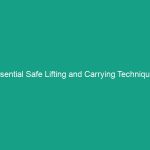Introduction
In the world of construction, safety is paramount. Every year, thousands of workers face Hazards that can lead to severe injuries or even fatalities. One of the most significant risks on construction sites is the danger posed by falling objects. Protection against falling objects in construction is crucial for safeguarding workers’ lives and ensuring compliance with Safety Regulations. This article delves deep into the essential measures, best practices, and regulatory frameworks that govern the protection against falling objects, providing valuable insights for construction professionals.
Understanding the Risk of Falling Objects
The construction industry is characterized by numerous activities taking place simultaneously, often at various heights. This Environment increases the likelihood of objects falling from scaffolding, cranes, or even workers’ hands. According to the Occupational Safety and Health Administration (OSHA), falling objects account for a significant percentage of construction-related injuries. Understanding the types of falling objects and their potential impact is the first step in developing effective Safety Strategies.
Types of Falling Objects
Falling objects can range from hand tools to heavy machinery components. Common examples include:
- Hand Tools: Tools that slip from a worker’s hands can cause serious injuries to those below.
- Building Materials: Items such as bricks, steel beams, or lumber can fall during lifting or transport.
- Construction Debris: Items that become dislodged during work activities, such as loose nails or pieces of wood.
Recognizing these risks allows construction managers to implement appropriate Safety Measures effectively.
Impact of Falling Objects
The impact of falling objects can be devastating. Injuries can range from minor bruises to severe head trauma, fractures, and even fatalities. The consequences extend beyond physical harm; they also include financial costs related to medical expenses, legal fees, and lost productivity. Ensuring robust protection against falling objects in construction not only saves lives but also protects the financial health of the project.
Regulatory Frameworks Governing Safety
Regulatory bodies play a crucial role in establishing safety Standards for construction sites. Organizations such as osha in the United States and the Health and Safety Executive (HSE) in the UK set regulations that dictate the necessary Safety Measures for protecting workers from falling objects.
OSHA Regulations
OSHA’s regulations provide guidelines for Fall Protection, including specific requirements for the use of Personal Protective Equipment (PPE) and safety measures to prevent falling objects. One key regulation is the requirement for employers to ensure that all tools and materials are secured when working at heights. Failure to comply with these regulations can result in severe penalties and increased liability.
HSE Guidelines
In the UK, the HSE emphasizes the importance of risk assessments and implementing Control Measures to mitigate the risks of falling objects. According to HSE guidelines, employers are required to evaluate the work environment and develop a comprehensive safety plan that includes protective measures against falling objects.
Best Practices for Protection Against Falling Objects
Implementing Best Practices is essential for effective protection against falling objects in construction. These practices not only enhance worker safety but also foster a culture of safety within the organization.
Conducting Thorough Risk Assessments
A comprehensive risk assessment is the foundation of any safety strategy. This process involves identifying potential Hazards, evaluating the risks associated with those hazards, and implementing Control Measures to mitigate them. Regularly updating risk assessments ensures that new risks are addressed promptly.
Using Personal Protective Equipment (PPE)
PPE plays a vital role in protecting workers from falling objects. Hard hats are essential for shielding the head from impacts, and high-visibility clothing can help ensure workers are seen in busy environments. Additionally, safety glasses can protect against debris that may fall or be kicked up from the site.
Implementing Effective Barricades and Safety Nets
Installing barricades around areas where materials are being lifted or moved can significantly reduce the risk of falling objects. Safety nets can also be beneficial in catching any falling debris, providing an additional layer of protection for workers below. Both measures should be used in conjunction with other safety practices to enhance overall safety.
Training and Awareness Programs
Regular Training for workers on the risks associated with falling objects and the proper use of safety equipment is crucial. Training programs should include hands-on demonstrations and real-world scenarios to reinforce learning. Additionally, fostering a culture of safety where workers feel empowered to report unsafe conditions can lead to a safer work environment.
Regular Equipment Inspections
Ensuring that all equipment is in good working condition is essential for preventing accidents. Regular inspections of lifting devices, scaffolding, and tools can help identify worn or damaged equipment that may pose a risk. Maintenance schedules should be strictly followed to ensure all equipment meets safety standards.
Case Studies: Successful Implementation of Safety Measures
Examining case studies of successful safety implementations provides valuable insights into effective strategies for protection against falling objects in construction.
Case Study 1: High-Rise Building Construction
In a recent high-rise construction project, a major contractor implemented a comprehensive safety program that included installing safety nets and ensuring all workers wore hard hats at all times. The contractor also conducted daily safety briefings to address potential hazards. As a result, the project reported zero incidents related to falling objects throughout its duration, showcasing the effectiveness of proactive safety measures.
Case Study 2: Bridge Renovation Project
During a bridge renovation project, a construction firm faced challenges with the potential for falling debris. To mitigate this risk, the firm employed a combination of overhead protection systems and safety barriers. They also trained workers extensively on the risks and proper handling of materials. The outcome was a significant reduction in near-miss incidents and a safer working environment for all personnel involved.
Challenges in Implementing Safety Measures
Despite the best intentions, implementing effective protection against falling objects in construction can be fraught with challenges. Identifying these obstacles is essential for developing effective solutions.
Cost Constraints
One of the primary challenges is budget limitations. Investing in safety measures, such as high-quality PPE and safety net systems, can be costly. However, it is crucial to view these investments as long-term savings when considering the potential costs of accidents and injuries.
Worker Compliance
Another challenge is ensuring worker compliance with safety protocols. Workers may sometimes neglect safety measures due to time pressures or a perceived lack of risk. Continuous training and fostering a culture of safety can help address this issue, ensuring that all personnel understand the importance of adhering to safety measures.
Dynamic Work Environments
The dynamic nature of construction sites can complicate safety implementations. As projects evolve, new risks may emerge, necessitating constant vigilance and adaptability in safety strategies. Regular site assessments and updates to safety protocols are essential to address these changing conditions.
Future Trends in Construction Safety
As technology advances and the construction industry evolves, new trends are emerging that can enhance protection against falling objects in construction.
Increased Use of Technology
Technological advancements, such as drones and augmented reality, are becoming increasingly prevalent in construction. Drones can assist in monitoring safety conditions from above, providing real-time data on potential risks associated with falling objects. Augmented reality can enhance training programs by simulating hazardous environments, allowing workers to experience and learn how to respond to potential risks safely.
Emphasis on Mental Health and Well-Being
Recognizing the importance of mental health in maintaining safety is gaining traction in the construction industry. Mental well-being plays a critical role in ensuring that workers are alert and focused, reducing the likelihood of accidents related to distractions or fatigue. Programs that support mental health can lead to safer work environments and improved overall productivity.
Conclusion
Protection against falling objects in construction is a vital aspect of Workplace Safety that should never be overlooked. By understanding the risks, adhering to regulatory frameworks, implementing Best Practices, and learning from real-world case studies, construction professionals can make significant strides in safeguarding their workers. Investing in safety not only protects lives but also enhances project efficiency and reputation. As we look to the future, embracing technology and prioritizing mental health will further strengthen safety measures in the construction industry. Let us commit to creating safer construction sites for everyone involved—because every worker deserves to go home safe.


